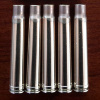I did some digging around and found a post by the engineer who designed the Annie annealer. The "saddle" effect from one anneal makes sense given the shape of the magnetic field's flux lines. My experience has been that case rotation or two anneals 90° out of phase is the solution even though Mr DeArmond states that it's not necessary.
"I'm John DeArmond, the engineer behind the Annie. Maybe I can answer some questions about the unit.
This is a true induction heater. IT heats the brass by causing a current to flow in the brass via transformer action.
The current both flows in a circle under each pole and around the periphery of the brass. So there are two initial hotspots but the heat rapidly equalizes. Except for the largest cases such as the .50 BMG, rotation is not necessary.
Annie is thermally protected so it cannot be overheated. The setpoint is 50 deg C which is just about the point where touching the case becomes uncomfortable but not hot enough to cause a burn.
The ferrite material is essentially a glass so it will chip if abused and will crack of the temperature is suddenly changed. Under continuous use, the work coil and ferrite will rise to about 130 deg C before it equilibrates with the surrounding air. That is hot enough to be unpleasant to touch but both the ferrite and the work coil are OK at in that temperature range.
Depending on the ferrite gap and the caliber of the case being annealed, the work coil current is in the 90-100 amp range. The coil is sheathed with siliconized fiberglass sleeving to protect the coil from abrasions. This material is good for several hundred deg C so it is not affected by the heat in this application.
This is the same heating unit that Giraud is using in his automatic machine.
There are no current plans for a 240 volt unit.
We've discussed a water cooled work coil and flux concentrator. We went with air cooling to keep the cost down and because it's not really necessary in this application. We can easily enough do a water cooled work head. If interested, write to
[email protected].
We welcome all feedback and comments. Again, send them to
[email protected]. You may write me with technical questions at
[email protected]. I don't get around to forums very often so email is the best way to contact me.
Thanks guys,
John DeArmond
Chief Engineer
Fluxeon.com"











